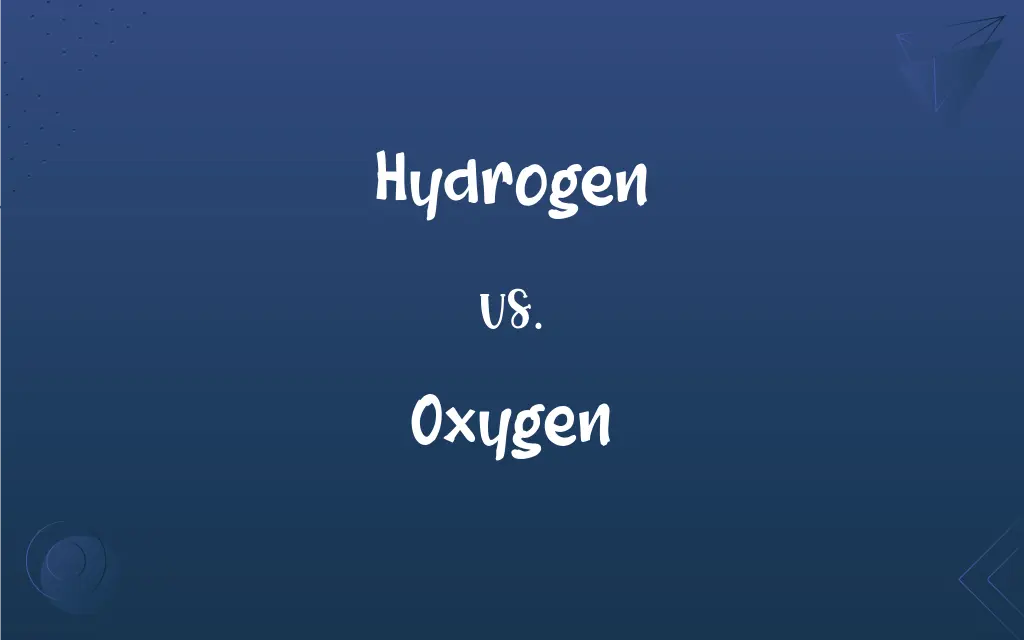Hydrogen vs. Oxygen: What's the Difference?
By Janet White || Published on December 27, 2023
Hydrogen is the lightest, simplest chemical element with one proton and one electron; oxygen is a more complex element with eight protons and often eight electrons, crucial for combustion and respiration.

Key Differences
Hydrogen, the first element on the periodic table, has just one proton and one electron, making it the simplest and lightest element. Oxygen, on the other hand, with eight protons and usually eight electrons, is more complex and heavier.
In water (H2O), hydrogen and oxygen combine in a 2:1 ratio. Two hydrogen atoms bond with one oxygen atom, demonstrating their chemical interplay and distinct roles in forming water molecules.
Hydrogen is a colorless, odorless gas at room temperature and is highly flammable. Oxygen, also a colorless and odorless gas at room temperature, supports combustion but is not flammable itself.
Hydrogen is fundamental in various organic compounds and plays a role in acid-base balance in organisms. Oxygen is essential for cellular respiration in aerobic organisms, highlighting its critical biological function.
Hydrogen has diverse applications, including in the production of ammonia and as a clean fuel source. Oxygen is widely used in medical applications, metal cutting and welding, and water treatment processes.
ADVERTISEMENT
Comparison Chart
Atomic Number
1
8
Atomic Weight
Approximately 1.008 amu
Approximately 15.999 amu
State at Room Temperature
Gas
Gas
Role in Water
Forms two parts of water molecule (H2O)
Forms one part of water molecule
Flammability
Highly flammable
Supports combustion but not flammable
ADVERTISEMENT
Biological Role
Involved in organic compounds and acid-base balance
Essential for cellular respiration
Industrial Applications
Used in ammonia production, fuel cells
Used in medical applications, welding, water treatment
Hydrogen and Oxygen Definitions
Hydrogen
The lightest chemical element with atomic number 1.
Hydrogen is used in fuel cells to produce clean energy.
Oxygen
A component of water and necessary for aerobic respiration.
Plants produce oxygen during photosynthesis.
Hydrogen
A colorless, odorless, and highly flammable gas.
The Hindenburg disaster highlighted the dangers of hydrogen's flammability.
Oxygen
Used in medical, industrial, and environmental applications.
Oxygen tanks are used by scuba divers.
Hydrogen
A component of water and many organic compounds.
Each molecule of water contains two atoms of hydrogen.
Oxygen
Supports combustion and is vital for life.
Fire requires oxygen to burn.
Hydrogen
Used in energy production and as a reducing agent.
Hydrogen fuel cells are a promising technology for sustainable energy.
Oxygen
A chemical element with atomic number 8, essential for respiration.
Oxygen is administered in hospitals to support patients' breathing.
Hydrogen
An element used in various chemical reactions and processes.
Hydrogen is vital in the Haber process for ammonia synthesis.
Oxygen
A colorless, odorless gas in its diatomic form, O2.
The Earth's atmosphere contains approximately 21% oxygen.
Hydrogen
A colorless, highly flammable element, that occurs as a diatomic molecule, H2, the lightest of all gases and the most abundant element in the universe, used in the production of synthetic ammonia and methanol, in petroleum refining, in the hydrogenation of organic materials, as a reducing atmosphere, in oxyhydrogen torches, in cryogenic research, and in rocket fuels. Atomic number 1; atomic weight 1.00794; melting point -259.1°C; boiling point -252.8°C; density at 0°C 0.08988 gram per liter; valence 1. See Periodic Table.
Oxygen
A nonmetallic element constituting 21 percent of the atmosphere by volume that occurs as a diatomic gas, O2, and in many compounds such as water and silica, and in iron ore. It combines with most elements, is essential for plant and animal respiration, and is required for nearly all combustion. Ozone, O3, is an allotrope of this element. Atomic number 8; atomic weight 15.9994; melting point -218.79°C; boiling point -182.9°C; gas density at 0°C 1.429 grams per liter; valence 2. See Periodic Table.
Hydrogen
The lightest chemical element (symbol H), with an atomic number of 1 and atomic weight of 1.00794. Category:en:Hydrogen
Oxygen
The chemical element (symbol O) with an atomic number of 8 and relative atomic mass of 15.9994. It is a colorless and odorless gas. Category:en:Oxygen
Hydrogen
An atom of the element.
Oxygen
Molecular oxygen (O2), a colorless, odorless gas at room temperature, also called dioxygen.
Hydrogen
Molecular hydrogen (H2), a colourless, odourless and flammable gas at room temperature.
Oxygen
(medicine) A mixture of oxygen and other gases, administered to a patient to help them breathe.
Hydrogen
A molecule of this molecular species
Oxygen
(countable) An atom of this element.
Hydrogen
A sample of the element/molecule.
Oxygen
(figurative) A condition or environment in which something can thrive.
Silence is the oxygen of shame.
They hoped to starve the terrorists of the oxygen of publicity.
Hydrogen
A gaseous element, colorless, tasteless, and odorless, the lightest known substance, being fourteen and a half times lighter than air (hence its use in filling balloons), and over eleven thousand times lighter than water. It is very abundant, being an ingredient of water and of many other substances, especially those of animal or vegetable origin. It may by produced in many ways, but is chiefly obtained by the action of acids (as sulphuric) on metals, as zinc, iron, etc. It is very inflammable, and is an ingredient of coal gas and water gas. It is standard of chemical equivalents or combining weights, and also of valence, being the typical monad. Symbol H. Atomic weight 1.
Oxygen
A colorless, tasteless, odorless, gaseous element of atomic number 8, occurring in the free state in the atmosphere, of which it forms about 23 per cent by weight and about 21 per cent by volume, being slightly heavier than nitrogen. Symbol O. Atomic weight 15.9994.
Hydrogen
A nonmetallic univalent element that is normally a colorless and odorless highly flammable diatomic gas; the simplest and lightest and most abundant element in the universe
Oxygen
Chlorine used in bleaching.
Oxygen
A nonmetallic bivalent element that is normally a colorless odorless tasteless nonflammable diatomic gas; constitutes 21 percent of the atmosphere by volume; the most abundant element in the earth's crust
FAQs
What is hydrogen primarily used for?
Hydrogen is used in fuel cells, chemical synthesis, and as a reducing agent.
Is hydrogen used in space exploration?
Yes, hydrogen is used as a fuel in rockets and space shuttles.
Is hydrogen found in the human body?
Yes, hydrogen is a component of water and organic molecules in the body.
Can hydrogen exist as a liquid?
Yes, hydrogen can be liquefied under very low temperatures and high pressure.
Are hydrogen and oxygen found in the Earth's atmosphere?
Yes, but oxygen is much more abundant than hydrogen in the atmosphere.
Why is oxygen important for life?
Oxygen is crucial for cellular respiration in aerobic organisms.
How do plants produce oxygen?
Plants release oxygen as a byproduct of photosynthesis.
What are the dangers of hydrogen?
Hydrogen is highly flammable and can be explosive under certain conditions.
How is hydrogen produced industrially?
It's commonly produced by steam reforming of natural gas and electrolysis of water.
Can hydrogen be used in vehicles?
Yes, hydrogen fuel cell vehicles are an emerging technology.
Why is oxygen used in metal cutting?
Oxygen supports the combustion process, making metal cutting more efficient.
Can hydrogen be a renewable energy source?
Yes, especially when produced using renewable energy sources.
Is oxygen therapy common in medical treatments?
Yes, particularly for respiratory ailments and emergency care.
How does oxygen benefit athletes?
Supplemental oxygen can help athletes recover faster and perform better.
What happens when hydrogen burns in the presence of oxygen?
It produces water (H2O) and releases energy.
Can oxygen be toxic?
In high concentrations, oxygen can be toxic and cause oxidative stress.
How do plants and animals use oxygen?
They use oxygen for cellular respiration to generate energy.
Is hydrogen part of the Earth's natural water cycle?
Yes, as a component of water, it is integral to the water cycle.
What makes oxygen essential in hospitals?
It's vital for patient care, particularly in respiratory therapy and anesthesia.
What role does oxygen play in water treatment?
Oxygen is used in processes like ozonation to purify water.
About Author
Written by
Janet WhiteJanet White has been an esteemed writer and blogger for Difference Wiki. Holding a Master's degree in Science and Medical Journalism from the prestigious Boston University, she has consistently demonstrated her expertise and passion for her field. When she's not immersed in her work, Janet relishes her time exercising, delving into a good book, and cherishing moments with friends and family.






































































